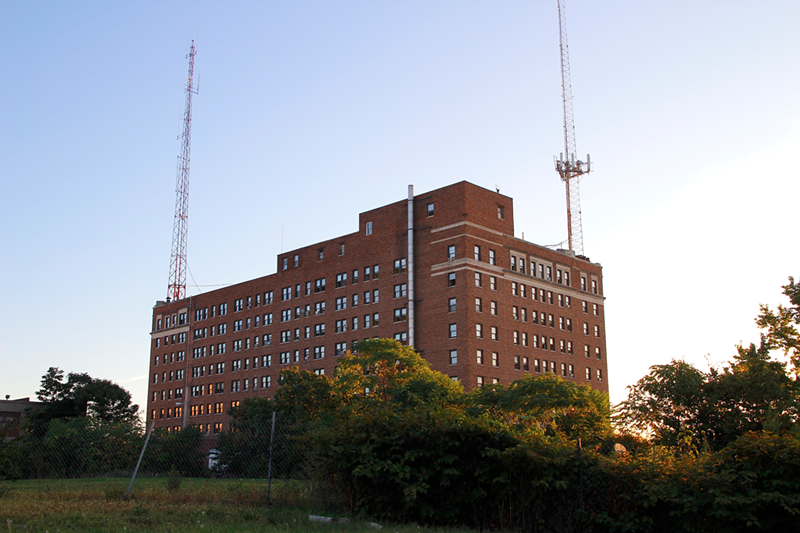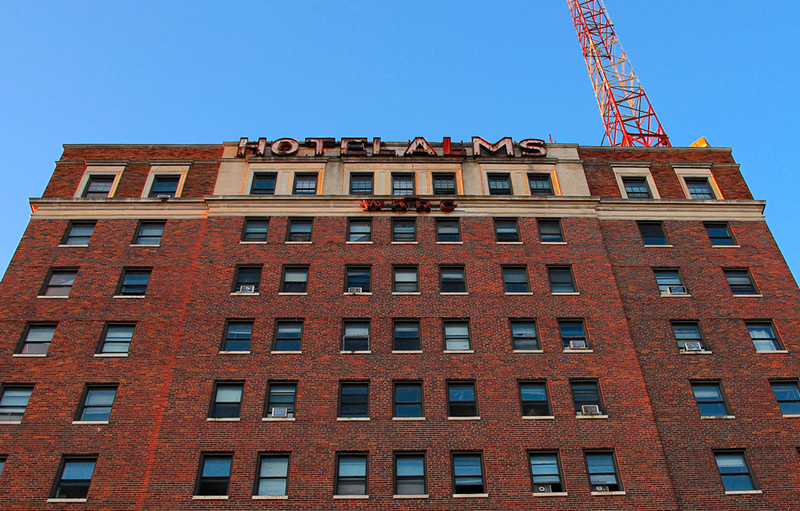For the last three decades, 76-year-old Aaron Jamison has lived in The Alms, a sprawling former luxury hotel at 2525 Victory Parkway. He and his late wife moved there in the 1980s, right around the time the U.S. Department of Housing and Urban Development signed a contract to provide Housing Assistance Payments for its low income residents.
He doesn't want to leave, but he may have to soon as HUD pulls out of the building.
Over the years, longtime residents at the Alms witnessed the grand, red brick structure slowly sink like an unmanned ship. They navigated gloomy, under-lit hallways. They got trapped in its malfunctioning elevators. Bedbugs and roaches infested some of their units; others went without heat for months at a time.
Now, after decades of neglect by a succession of owners, HUD is acting to end its subsidies on the building — though it ignored warnings from city officials and its inspections just a few years ago didn’t detect the declining conditions there. Ironically, HUD’s move comes right as the Alms might be turning a corner.
“There had been a series of terrible property managers and owners who did no real work at the property, not even routine maintenance, and just collected the rent,” 20-year resident Jeanette Coleman said in recent court documents about the Alms.
After filing July 31 to terminate its subsidies to the property, HUD is locked in what might be a final legal battle with the building’s residents, the Greater Cincinnati Homeless Coalition and the Legal Aid Society of Greater Cincinnati.
The groups have filed a federal lawsuit seeking an injunction that would prevent HUD from pulling out of the Alms. Because the vast majority of the building’s residents are low-income and black, and because many like Jamison are disabled, the lawsuit says HUD is violating the federal Fair Housing Act.
“HUD chose not to pursue other alternatives available to it that would have had less severe adverse fair housing effects, and has failed to affirmatively further the fair housing rights of the plaintiffs,” Legal Aid attorney Virginia Tallent wrote in an initial filing for the lawsuit.
Residents say they were not informed about HUD’s plans until Legal Aid told them and that HUD did not ask their opinion on the matter prior to its decision.
The latest in the showdown came Sept. 22, when HUD officials met with the groups and listened to residents but did not answer questions.
The stakes are high. HUD leaving the Alms would likely mean the loss of 200 units of affordable housing in Walnut Hills. Just blocks away, dotted among old brick buildings on McMillan Avenue wearing ghost signs and graffiti, there are new bars, restaurants and market rate condos rising — lifting rents with them and making Alms residents nervous they won’t have a place to go there.
It might be hard to find more affordable digs in other neighborhoods as well. The Greater Cincinnati area has a 40,000 unit deficit when it comes to affordable housing, a recent LISC study suggests.
In the past year, Jamison and other residents say, the Alms’ condition has gotten better. The Alms Residents Association, the Homeless Coalition and Legal Aid in 2015 pushed the city of Cincinnati to appoint a receiver for the Alms and other troubled buildings owned by PE Holdings, which is based in New Jersey.
That receiver, Indianapolis-based Milhaus Management, has been working on the buildings since April 2016 and has made more than $4 million in repairs to properties once controlled by PE Holdings. That includes more than $700,000 fixing the Alms’ electrical systems and roof, rehabbing individual units and replacing the elevators, according to documents the developer provided to HUD.
In that time, however, the building has had unforeseen challenges. Edward Cunningham, city of Cincinnati property maintenance code compliance enforcement director, said in a court filing that a January fire likely caused by faulty wiring installed by past owners has slowed progress at the Alms, as has an August 2016 sewage backup.
Despite these events, Cunningham says, Milhaus and new subcontractor Hayes-Gibson have made progress on addressing some 450 code issues — including non-functioning heat, insect infestations, roof issues and other major problems — a city inspector documented in November of 2015.
Roughly 260 of those violations have been cleared and another 100 are awaiting final approval, according to a letter from Milhaus’ attorneys to HUD. Ninety outstanding violations are associated with unoccupied units awaiting rehabilitation, and other violations are associated with the recent fire.
“The city has not issued an order to vacate the entire building because such an action is not necessary at this time,” Cunningham said in his filing, noting that the city has been in contract with HUD advising officials that the building is safe for occupancy and asking it not to pull out.
The building wasn’t always so fraught with problems. The current Alms was a 1925 expansion of a now-demolished hotel built by department store magnate Frederick Alms in 1891. For decades, the building was a bustling hub for upscale travelers and events, at one time hosting one of the city’s most prominent black clubs in its expansive ballroom, and later, the studios of radio station WKRC.
But by the 1970s, the hotel had gone out of business and the Alms became apartments. In some ways, the Alms’ fate mirrors the fate of Walnut Hills and Cincinnati’s other inner city neighborhoods — a place plagued by disinvestment and increasing levels of concentrated poverty where predominantly black residents have had to live with sub-par conditions.
“This was really a nice place,” Albert Hawkins, who says he’s lived at the Alms for four decades, told CityBeat last year.
From the building’s half-lit community room, he pointed to the spot outside a set of side doors once occupied by a pool, complete with beach lamps and umbrellas on the patio.
“It was for working people, but it was really beautiful, wasn’t falling down. It’s changed hands so many times, I don’t ever get to meet the people who own it.”
Seattle-based Security Properties, Inc. purchased the building in 1984. In the two decades the company owned it, the Alms became increasingly troubled. HUD cut subsidies to landlords across the country, impacting the owners’ bottom line — and motivation to do maintenance. Residents said they feared retaliation if they lodged complaints with the building’s revolving door of property managers.
By 2002, the building had failed a HUD real estate assessment center (REAC) inspection. Seeking to force the owners to make improvements, the city threatened to sue two years later. In late 2006, Cincinnati-based Downtown Property Management, which ran more than 5,000 units of housing in the city, purchased the building.
Neighborhood leaders expressed optimism at the time of the sale, especially given DPM’s indication that it wanted to eventually turn the Alms into market-rate condos. But DPM itself would soon draw scrutiny from the city.
In 2013, 20 DPM properties saw nearly 1,100 nuisance calls to the city. Many of those were from buildings like the Alms. After selling the Alms and several other buildings in its portfolio to New Jersey-based PE Holdings in 2013, complaints against DPM properties dropped significantly.
Neighborhood groups sounded alarms as PE Holdings sought to purchase the Alms and other DPM buildings.
Avondale Community Council President Patricia Milton and Avondale Comprehensive Development Corporation President Ozie Davis III told the city the deal reminded them of a similar 2007 purchase by an out of town LLC, funded by the same lenders, that eventually led to the foreclosure of buildings holding more than 600 units of HUD-subsidized housing in Avondale and other neighborhoods.
“We have visions of (this) scenario happening all over again and as such, many of us in Cincinnati are very concerned about this transaction moving forward,” they wrote.
In 2013, then-Cincinnati Community and Economic Development Director Michael Cervay met with other city officials and representatives from PE Holdings. After the meeting, Cervay fired off a letter to the U.S. Department of Housing and Urban Development asking the federal government to keep the company from buying the properties.
“It was made clear to the participants in that meeting that the new owners have no intention of investing in our neighborhoods through the purchase of this portfolio,” Cervay wrote to HUD in April that year. “(PE Holding’s representative) stated that there are no plans for capital improvements or rehabilitation, a dialogue with the neighborhoods, nor their own new residents regarding what is needed to preserve these buildings.”
That red flag proved both prescient and ineffective. HUD gave the purchase the green light, and two years later, city code inspectors found horrendous conditions in the Alms and several other buildings PE Holdings had purchased. Then came frightening reports of threats from building managers toward tenants, including incidents in which residents were reportedly threatened with firearms.
Oddly, just prior to the sale, the Alms was earning sky-high scores on HUD REAC inspections. In 2012, just before PE Holdings purchased it, the building scored a 95 on a REAC inspection, HUD records show. By HUD’s practices, that meant it wouldn’t get another inspection for three years.
The high score doesn’t surprise residents.
“HUD would send out inspectors every so often to look at the condition of the building,” resident Coleman says of earlier inspections. “The inspectors never seemed at all concerned about how bad the conditions were. HUD would score the building very well and say that it was in good condition even though conditions at the property and in individual apartments were deteriorating.”
Another REAC inspection scored the Alms at 49 in April 2015 — months after alarming conditions came to light via city code inspections. In December that year, the Alms scored a 21 on yet another REAC inspection after more media and city reports of the conditions there.
Now, even after a court stripped PE Holdings of control of the building and receiver Milhaus has spent the hundreds of thousands of dollars in improvements to the Alms, its REAC score —20 — is lower than scores received during the three-year period when PE Holdings ran it. The latest low score prompted HUD’s decision to pull its subsidies from the Alms.
But the department will have to fight a battle in the Sixth Circuit Court of Appeals with residents, the Homeless Coalition and Legal Aid. The situation is in stasis until hearings on the residents’ lawsuit start up in October.
That’s left residents like Jamison, Coleman and others in limbo.
Jamison’s grandson lives nearby. He likes the Alms’ location, his neighbors in the building, the memories he has there and the ease with which doctors and nurses helping him with his diabetes can visit him. He pays about $250 a month for his apartment, and is worried that he will not be able to find another affordable place to stay in rapidly changing Walnut Hills.
“It would be a real burden on me to move after so many years of living in the same place,” Jamison says. “I would like to spend the rest of my life living at the Alms.”







